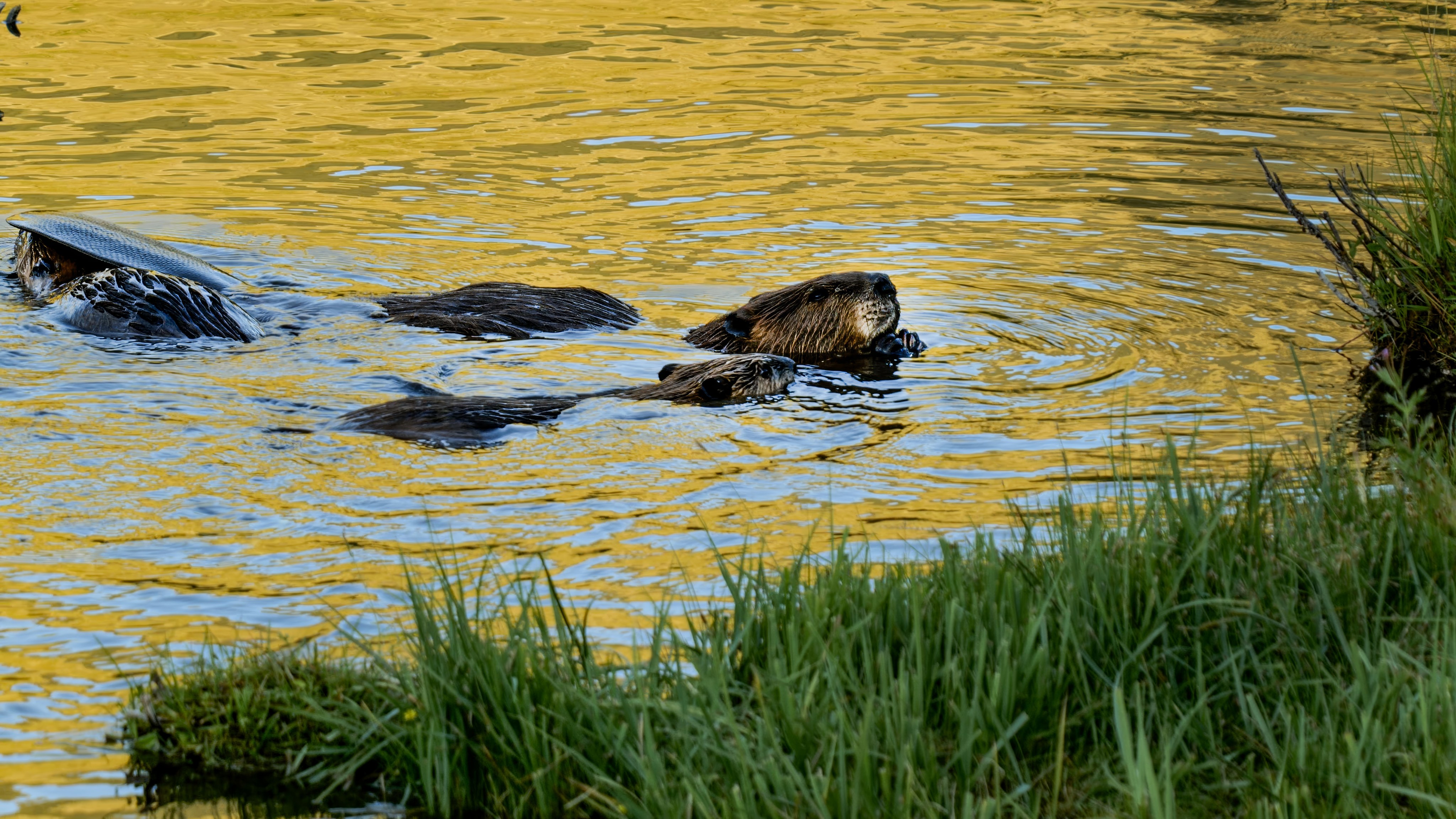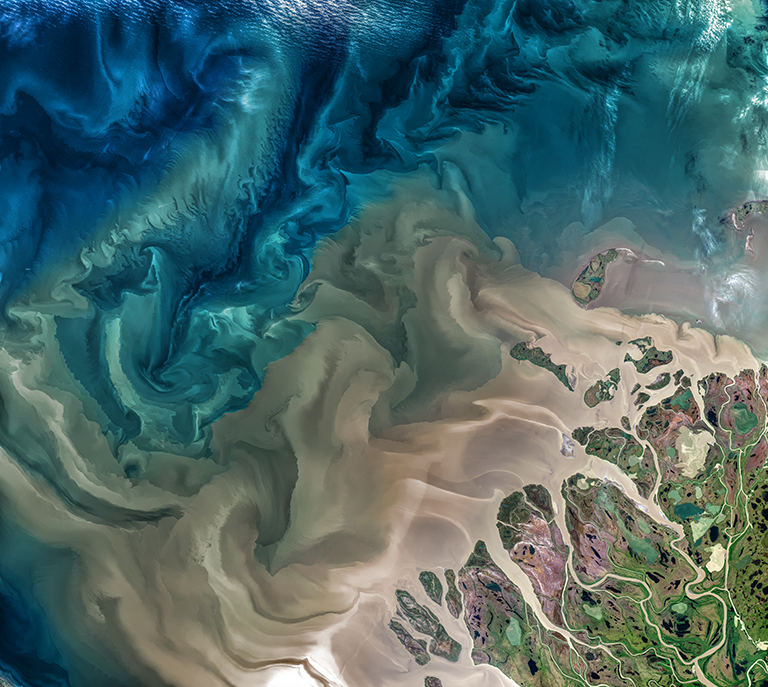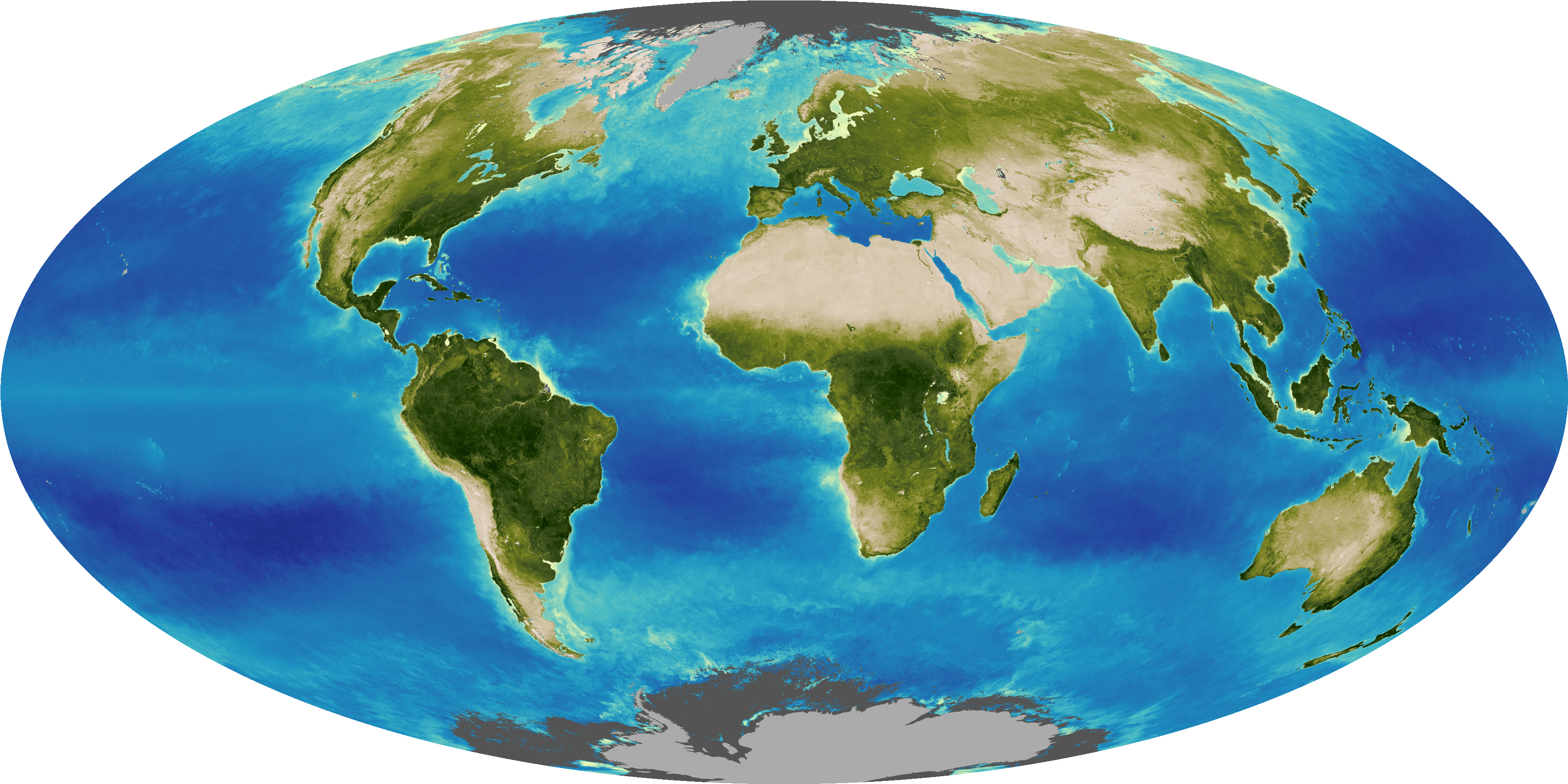11 min read
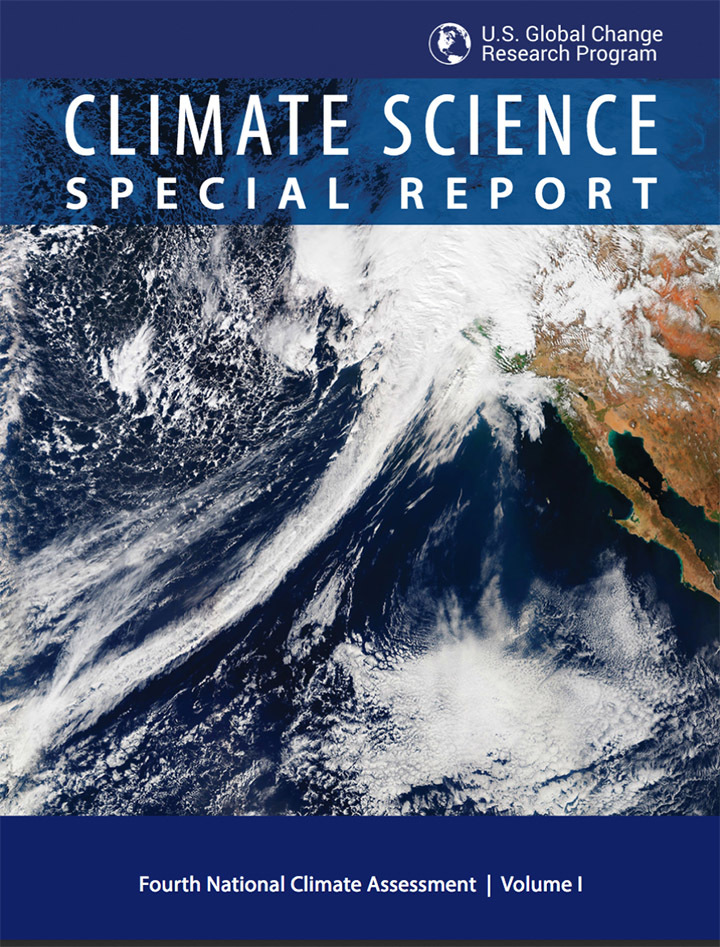
NASA Earth Observatory readers may recognize this image of a long trail of clouds — an atmospheric river — reaching across the Pacific Ocean toward California. It appeared first as an Image of the Day about how these moisture superhighways fueled a series of drought-busting rain and snow storms.
More recently, we were pleased to see that image on the cover of the Fourth National Climate Assessment — a major report issued by the U.S. Global Research Program. That image was one of many from Earth Observatory that appeared in the report. Since the authors did not give much background about the images, here is a quick rundown of how they were created and how they fit with some of the key points on our changing climate.
Found in Chapter 1: Our Globally Changing Climate
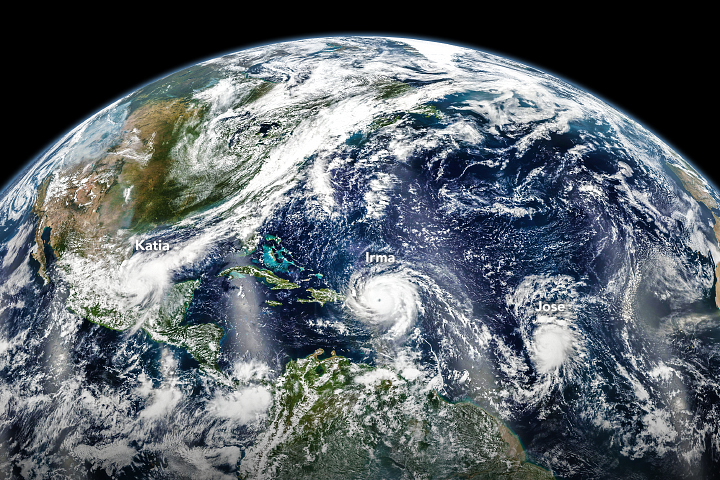
Three hurricanes — Katia, Irma, and Jose — marching across the Atlantic Ocean on September 6, 2017.
The frequency of the most intense hurricanes is projected to increase in the Atlantic and the eastern North Pacific. Sea level rise will increase the frequency and extent of extreme flooding associated with coastal storms, such as hurricanes.
The Visible Infrared Imaging Radiometer Suite (VIIRS) on the Suomi NPP satellite collected the data. Earth Observatory staff combined several scenes, taken at different times, to create this composite. Original source of the image: Three Hurricanes in the Atlantic
Found in Chapter 2: Physical Drivers of Climate Change
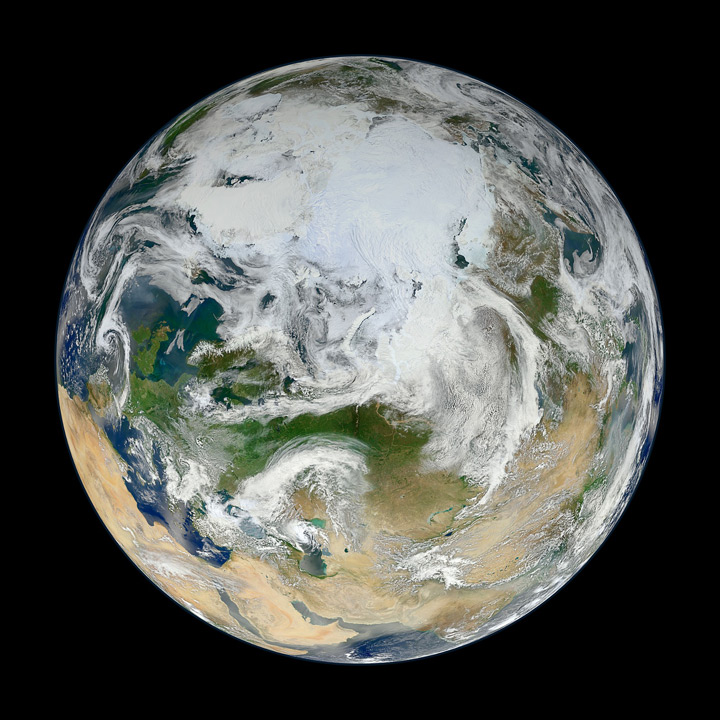
Clouds swirl over sea ice, glaciers, and green vegetation in the Northern Hemisphere, as seen on a spring day from an angle of 70 degrees North, 60 degrees East.
Over the past 50 years, near-surface air temperatures across Alaska and the Arctic have increased at a rate more than twice as fast as the global average. It is very likely that human activities have contributed to observed Arctic warming, sea ice loss, glacier mass loss, and a decline in snow extent in the Northern Hemisphere.
Ocean scientist Norman Kuring of NASA’s Goddard Space Flight Center pieced together this composite based on 15 satellite passes made by VIIRS/Suomi NPP on May 26, 2012. The spacecraft circles the Earth from pole to pole, so it took multiple passes to gather enough data to show an entire hemisphere without gaps. Original source of the image: The View from the Top
Found in Chapter 3: Detection and Attribution of Climate Change
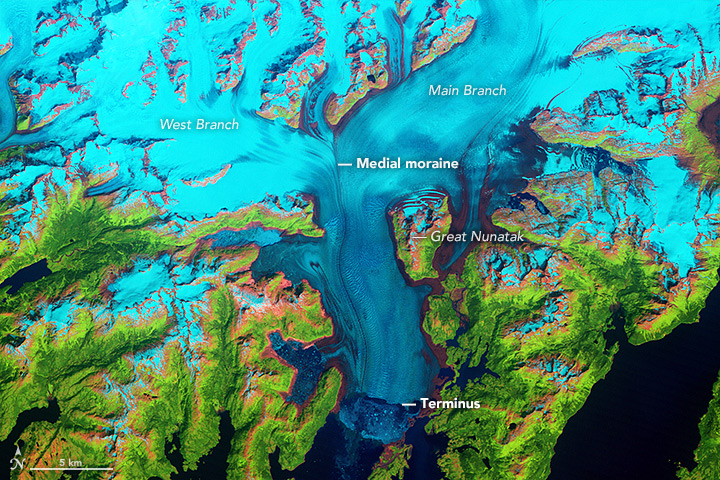
Columbia Glacier in Alaska, one of the most rapidly changing glaciers in the world.
The collective ice mass of all Arctic glaciers has decreased every year since 1984, with significant losses in Alaska.
NASA Earth Observatory visualizers made this false-color image based on data collected in 1986 by the Thematic Mapper on Landsat 5. The image combines shortwave-infrared, near-infrared, and green portions of the electromagnetic spectrum. With this combination, snow and ice appears bright cyan, vegetation is green, clouds are white or light orange, and open water is dark blue. Exposed bedrock is brown, while rocky debris on the glacier’s surface is gray. Original source of the image: World of Change: Columbia Glacier
Found in Intro to Chapter 4: Climate Models, Scenarios, and Projections
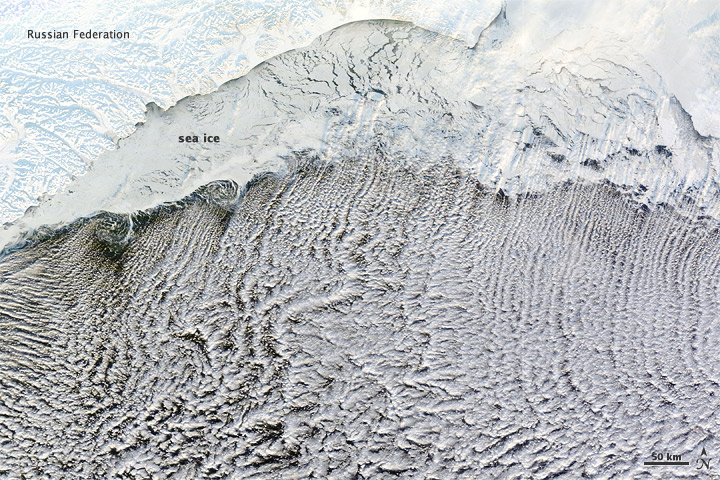
Sea ice hugging the Russian coastline and cloud streets streaming over the Bering Sea.
Climate feedbacks are the largest source of uncertainty in quantifying climate sensitivity — that is, how much global temperatures will change in response to the addition of more greenhouse gases to the atmosphere.
The Moderate Resolution Imaging Spectroradiometer (MODIS) on NASA’s Terra satellite captured this natural-color image on January 4, 2012. The LANCE/EOSDIS MODIS Rapid Response Team generated the image, and NASA Earth Observatory staff cropped and labeled it. Original source of the image: Cloud streets over the Bering Sea
Found in Intro to Chapter 5: Large-scale circulation and climate variability
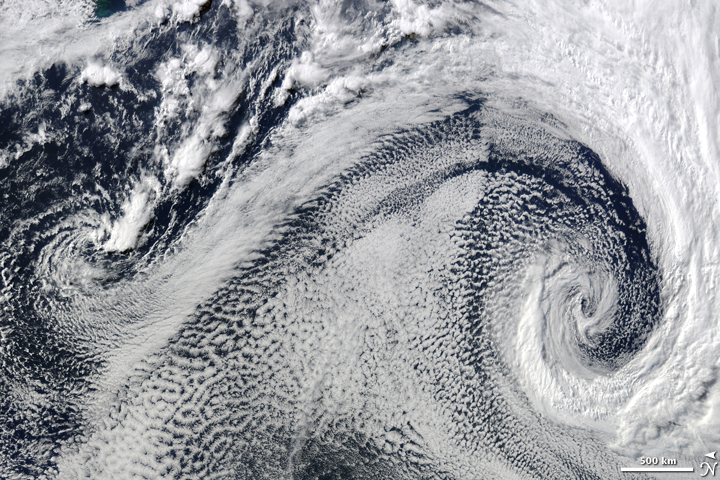
Two extratropical cyclones, the cause of most winter storms, churned near each other off the coast of South Africa in 2009.
There is uncertainty about future changes in winter extratropical cyclones. Activity is projected to change in complex ways, with increases in some regions and seasons and decreases in others. There has been a trend toward earlier snowmelt and a decrease in snowstorm frequency on the southern margins of snowy areas. Winter storm tracks have shifted northward since 1950 over the Northern Hemisphere.
The Moderate Resolution Imaging Spectroradiometer (MODIS) on NASA’s Terra satellite captured this natural-color image. The LANCE/EOSDIS MODIS Rapid Response Team generated the image and NASA Earth Observatory staff cropped and labeled it. Original source of the image: Cyclonic Clouds over the South Atlantic Ocean
Found in Chapter 6: Temperature Changes in the United States
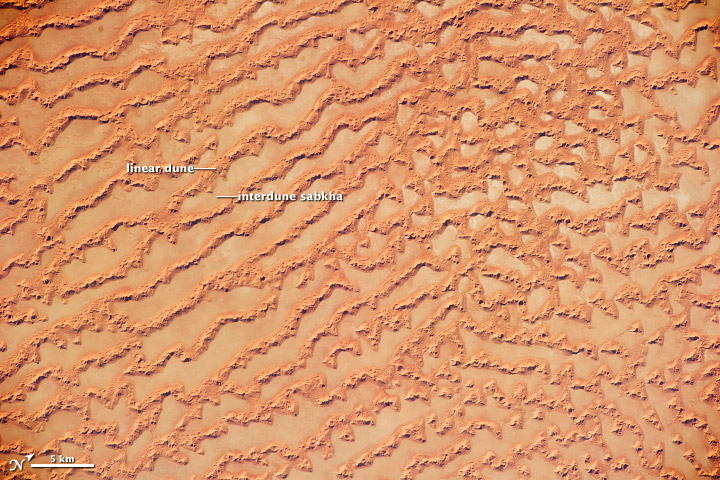
Large, linear sand dunes alternating with interdune salt flats in the Rub’ al Khali in the Sultanate of Oman.
The human effect on droughts is complicated. There is little evidence for a human influence on precipitation deficits, but a lot of evidence for a human fingerprint on surface soil moisture deficits — starting with increased evapotranspiration caused by higher temperatures. Decreases in surface soil moisture over most of the United States are likely as the climate warms. Assuming no change to current water resources management, chronic hydrological drought is increasingly possible by the end of the 21st century. Changes in drought frequency or intensity will also play an important role in the strength and frequency of dust storms.
How it was made: An astronaut on the International Space Station took the photograph with a Nikon D3S digital camera using a 200 millimeter lens on May 16, 2011. Original source of the image: Ar Rub’ al Khali Sand Sea, Arabian Peninsula
Found in Chapter 7: Precipitation Change in the United States
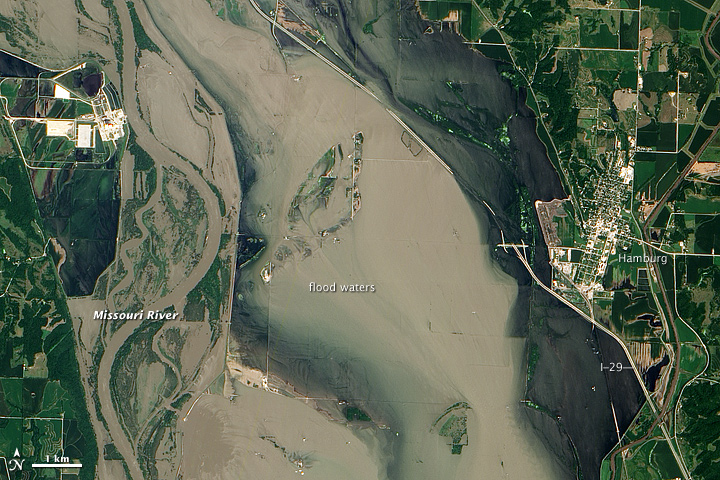
Sediment-rich flood water lingering on the Missouri River in July 2011.
Detectable changes in flood frequency have occurred in parts of the United States, with a mix of increases and decreases in different regions. Extreme precipitation, one of the controlling factors in flood statistics, is observed to have generally increased and is projected to continue to do. However, scientists have not yet established a significant connection between increased river flooding and human-induced climate change.
The Advanced Land Imager (ALI) on NASA’s Earth Observing-1 (EO-1) satellite captured the data for this natural-color image. NASA Earth Observatory staff processed, cropped, and labeled the image. Original source of the image: Flooding near Hamburg, Iowa
Found in Chapter 8: Droughts, Floods, and Wildfires
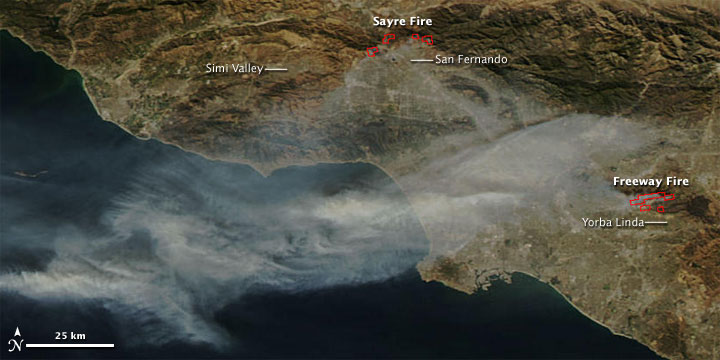
Smoke streaming from the Freeway fire in the Los Angeles metro area on November 16, 2008.
The incidence of large forest fires in the western United States and Alaska has increased since the early 1980s and is projected to further increase as the climate warms, with profound changes to certain ecosystems. However, other factors related to climate change — such as water scarcity or insect infestations — may act to stifle future forest fire activity by reducing growth or otherwise killing trees.
The MODIS Rapid Response Team made this image based on data collected by NASA’s Aqua satellite. Original source of the image: Fires in California
Found in Chapter 10: Changes in Land Cover and Terrestrial Biogeochemistry
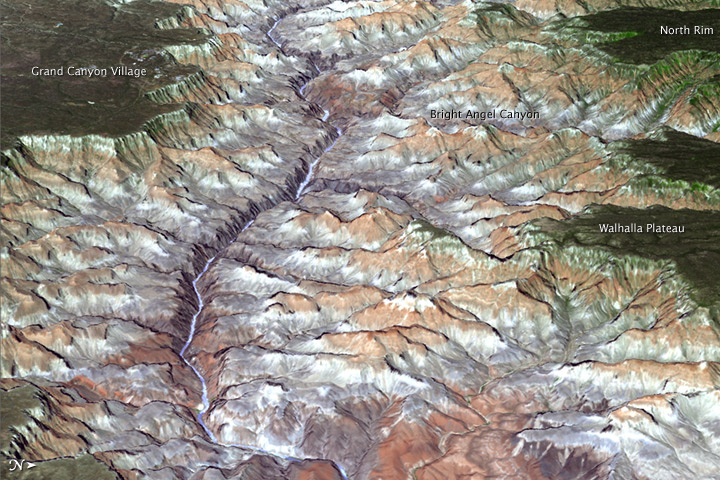
The Grand Canyon in northern Arizona.
The southwestern United States is projected to experience significant decreases in surface water availability, leading to runoff decreases in California, Nevada, Texas, and the Colorado River headwaters, even in the near term. Several studies focused on the Colorado River basin showed that annual runoff reductions in a warmer western U.S. climate occur through a combination of evapotranspiration increases and precipitation decreases, with the overall reduction in river flow exacerbated by human demands on the water supply.
On July 14, 2011, the ASTER sensor on NASA’s Terra spacecraft collected the data used in this 3D image. NASA Earth Observatory staff made the image by draping an ASTER image over a digital elevation model produced from ASTER stereo data. Original source of the image: Grand New View of the Grand Canyon
Found in Chapter 11: Arctic Changes and their Effects on Alaska and the Rest of the United States
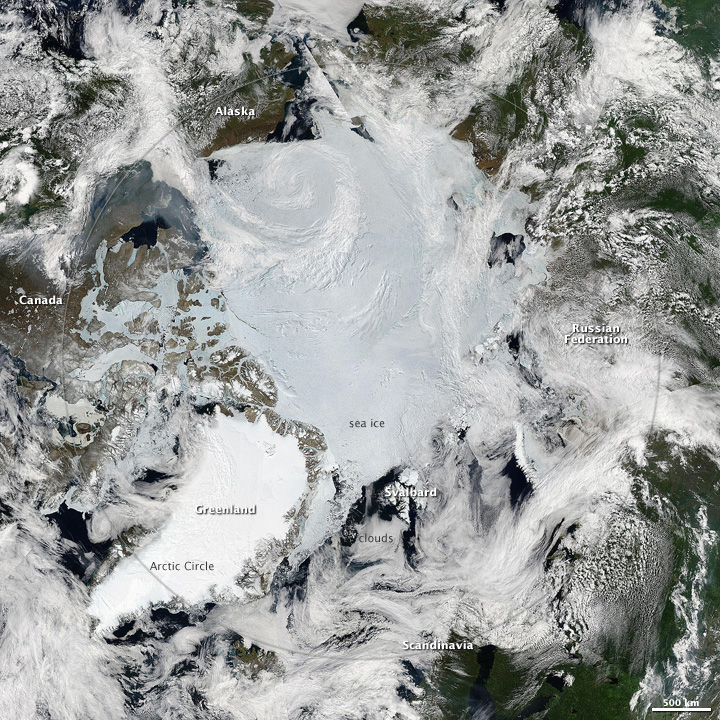
A clear view of the Arctic in June 2010. Clouds swirl over sea ice, snow, and forests in the far north.
Since the early 1980s, annual average Arctic sea ice has decreased in extent between 3.5 percent and 4.1 percent per decade, become 4.3 to 7.5 feet (1.3 and 2.3 meters) thinner. The ice melts for at least 15 more days each year. Arctic-wide ice loss is expected to continue through the 21st century, very likely resulting in nearly sea ice-free late summers by the 2040s.
Earth Observatory staff used data from several MODIS passes from NASA’s Aqua satellite to make this mosaic. All of the data were collected on June 28, 2010. Original source of the image: Sunny Skies Over the Arctic
Found in Chapter 12: Sea Level Rise
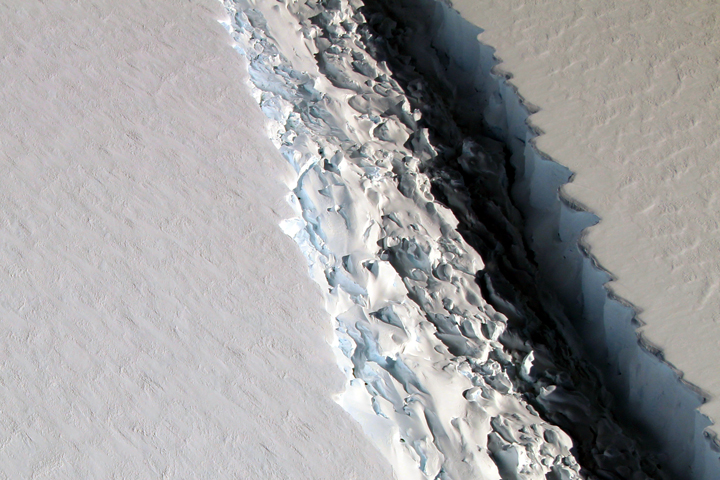
This photograph shows a rift in the Larsen C Ice Shelf as observed from NASA’s DC-8 research aircraft. An iceberg the size of Delaware broke off from the ice shelf in 2017.
Floating ice shelves around Antarctica are losing mass at an accelerating rate. Mass loss from floating ice shelves does not directly affect global mean sea level — because that ice is already in the water — but it does lead to the faster flow of land ice into the ocean.
NASA scientist John Sonntag took the photo on November 10, 2016, during an Operation IceBridge flight. Original source of the image: Crack on Larsen C
Found in Chapter 13: Ocean Acidification and Other Changes
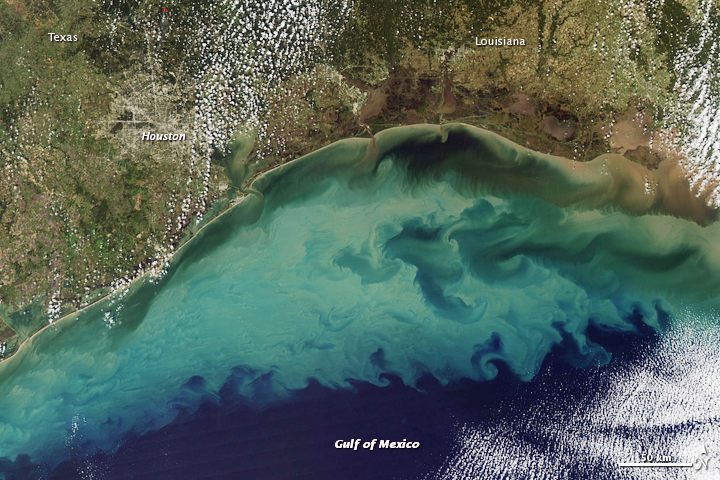
Suspended sediment in shallow coastal waters in the Gulf of Mexico near Louisiana.
The western Gulf of Mexico and parts of the U.S. Atlantic Coast (south of New York) are currently experiencing significant sea level rise caused by the withdrawal of groundwater and fossil fuels. Continuation of these practices will further amplify sea level rise.
The MODIS instrument on NASA’s Aqua satellite captured this natural-color image on November 10, 2009. Original source of the image: Sediment in the Gulf of Mexico
Found in Appendix D
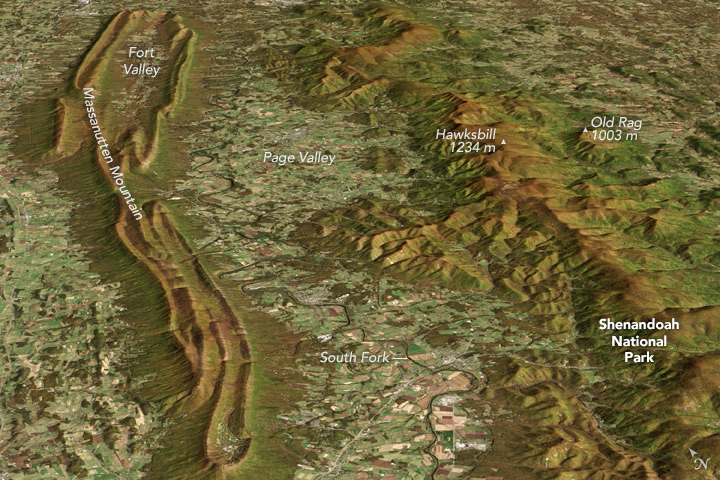
A fall scene showing farmland in the Page Valley of Virginia, between Shenandoah National Park and Massanutten Mountain.
Since 1901, the consecutive number of frost-free days and the length of the growing season have increased for the seven contiguous U.S. regions used in this assessment. However, there is important variability at smaller scales, with some locations actually showing decreases of a few days to as much as one to two weeks. However, plant productivity has not increased, and future consequences of the longer growing season are uncertain.
On October 21, 2013, the Operational Land Imager (OLI) on Landsat 8 captured a natural-color image of these neighboring ridges. The Landsat image has been draped over a digital elevation model based on data from the ASTER sensor on the Terra satellite. Original source of the image: Contrasting Ridges in Virginia
Found on the Cover and Executive Summary
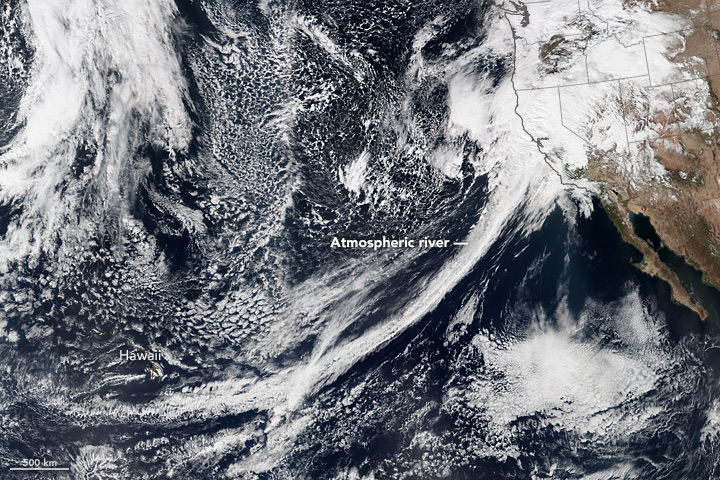
What the image shows: A tight arc of clouds stretching from Hawaii to California, which is a visible manifestation of an atmospheric river of moisture flowing into western states.
The frequency and severity of land-falling atmospheric rivers on the U.S. West Coast will increase as a result of increasing evaporation and the higher atmospheric water vapor content that occurs with increasing temperature. Atmospheric rivers are narrow streams of moisture that account for 30 to 40 percent of the typical snow pack and annual precipitation along the Pacific Coast and are associated with severe flooding events.
On February 20, 2017, the VIIRS on Suomi NPP captured this natural-color image of conditions over the northeastern Pacific. NASA Earth Observatory data visualizers stitched together two scenes to make the image. Original source of the image: River in the Sky Keeps Flowing Over the West
This piece was originally published on NASA Earth Observatory's Earth Matters blog.


